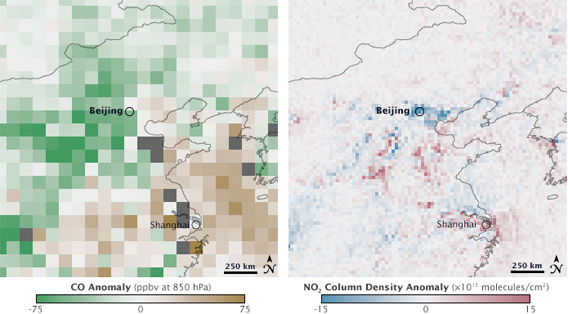|
|
China’s efforts to clean up Beijing’s skies during the Olympics seemed to have worked, reports NASA.
To reduce airborne particulate matter during the high-profile sporting event, the Chinese goverment shuttered factories, banned construction, and strictly controlled traffic. Now NASA scientists report the measures had an “unmistakable impact” with levels of nitrogen dioxide (NO2) — a noxious gas resulting from fossil fuel combustion — falling nearly 50 percent during the two months when restrictions were in place. Levels of carbon monoxide (CO) dipped 20 percent.
When authorities relaxed regulations, pollutant levels increased significantly.
“After the authorities lifted the traffic restrictions, the levels of these pollutants shot right back up,” said Jacquelyn Witte of NASA’s Goddard Space Flight Center, speaking at the fall meeting of the American Geophysical Union in San Francisco.

The left image shows the change in carbon monoxide concentrations over the North China Plain as observed by the Measurements of Pollution in the Troposphere (MOPITT) sensor on NASA’s Terra satellite in August 2008. Areas that are green indicate a decrease in carbon monoxide compared to average values observed during the month of August in 2005, 2006, and 2007. Brown areas show where carbon monoxide concentrations were higher than average. Unlike a ground-based sensor, which records the make-up of the air immediately around it, the satellite sensor measures wide swaths of the atmosphere at a time. In this case, each square represents an area about 100 kilometers across.
Clearly, carbon monoxide concentrations decreased most in the area immediately around Beijing. According to the researchers, led by atmospheric scientist Jacquelyn Witte, carbon monoxide concentrations over Beijing decreased by 20 percent. A drop in carbon monoxide would decrease smog formation and improve human health. Carbon monoxide affects people by limiting the amount of oxygen the blood can carry to organs like the heart and brain.
Nitrogen dioxide concentrations fell by 50 percent, as shown in the image on the right. The image was made with data collected by the Ozone Monitoring Instrument (OMI) on the Aura satellite. The image compares average nitrogen dioxide concentrations observed in August 2008 to the average value observed in August 2005, 2006, and 2007. Higher-than-average concentrations are red, while lower concentrations are blue. The squares in this image measure approximately 25 kilometers across. Again, the drop in nitrogen dioxide concentrations is centered around Beijing, where restrictions were greatest.
The decrease in nitrogen dioxide concentrations likely also contributed to brighter skies. Nitrogen dioxide is the reddish brown haze that often hangs over a city. Noxious on its own, the gas is also a precursor to ground-level ozone, which is the primary constituent of smog and causes respiratory problems.
The research shows how satellite measurements of pollutants can help scientists find more accurate ways to monitor the effectiveness of efforts to reduce emissions, says Kenneth Pickering, a researcher who collaborated on the project.
The researchers say China’s pollution experiment will help climate scientists refine their emissions models.